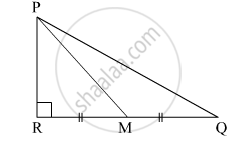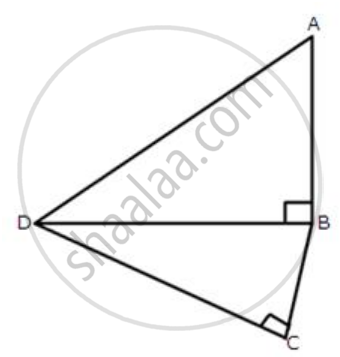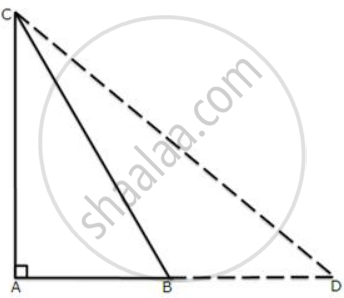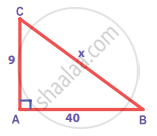Advertisements
Advertisements
प्रश्न
In the given figure, M is the midpoint of QR. ∠PRQ = 90°. Prove that, PQ2 = 4PM2 – 3PR2.

उत्तर
Given: M is the midpoint of QR. ∠PRQ = 90°.
To prove: PQ2 = 4PM2 – 3PR2
Proof:
In ∆PRM,
∠PRM = 90° ...(Given)
By Pythagoras theorem,
∴ PM2 = PR2 + RM2
∴ RM2 = PM2 − PR2 ...(1)
In ∆PRQ,
∠PRQ = 90° ...(Given)
By Pythagoras theorem,
∴ PQ2 = PR2 + RQ2
∴ PQ2 = PR2 + (RM + MQ)2 ...[M is the midpoint of QR]
∴ PQ2 = PR2 + (RM + RM)2
∴ PQ2 = PR2 + (2RM)2
∴ PQ2 = PR2 + 4RM2
∴ PQ2 = PR2 + 4(PM2 − PR2) ...(from 1)
∴ PQ2 = PR2 + 4PM2 − 4PR2
∴ PQ2 = 4PM2 − 3PR2
Hence, PQ2 = 4PM2 – 3PR2.
संबंधित प्रश्न
ABC is a right-angled triangle, right-angled at A. A circle is inscribed in it. The lengths of the two sides containing the right angle are 5 cm and 12 cm. Find the radius of the circle
An aeroplane leaves an airport and flies due north at a speed of 1,000 km per hour. At the same time, another aeroplane leaves the same airport and flies due west at a speed of 1,200 km per hour. How far apart will be the two planes after `1 1/2` hours?
Find the perimeter of the rectangle whose length is 40 cm and a diagonal is 41 cm.
The diagonals of a rhombus measure 16 cm and 30 cm. Find its perimeter.
Pranali and Prasad started walking to the East and to the North respectively, from the same point and at the same speed. After 2 hours distance between them was \[15\sqrt{2}\]
km. Find their speed per hour.
In ∆ABC, ∠BAC = 90°, seg BL and seg CM are medians of ∆ABC. Then prove that:
4(BL2 + CM2) = 5 BC2

The given figure shows a quadrilateral ABCD in which AD = 13 cm, DC = 12 cm, BC = 3 cm and ∠ABD = ∠BCD = 90o. Calculate the length of AB.
In triangle ABC, angle A = 90o, CA = AB and D is the point on AB produced.
Prove that DC2 - BD2 = 2AB.AD.
In figure AB = BC and AD is perpendicular to CD.
Prove that: AC2 = 2BC. DC.
ABC is a triangle, right-angled at B. M is a point on BC.
Prove that: AM2 + BC2 = AC2 + BM2
In ∆ ABC, AD ⊥ BC.
Prove that AC2 = AB2 +BC2 − 2BC x BD
In the given figure, angle ACP = ∠BDP = 90°, AC = 12 m, BD = 9 m and PA= PB = 15 m. Find:
(i) CP
(ii) PD
(iii) CD

In a triangle ABC, AC > AB, D is the midpoint BC, and AE ⊥ BC. Prove that: AB2 = AD2 - BC x CE + `(1)/(4)"BC"^2`
∆ABC is right-angled at C. If AC = 5 cm and BC = 12 cm. find the length of AB.
If in a ΔPQR, PR2 = PQ2 + QR2, then the right angle of ∆PQR is at the vertex ________
Find the unknown side in the following triangles
In ∆PQR, PD ⊥ QR such that D lies on QR. If PQ = a, PR = b, QD = c and DR = d, prove that (a + b)(a – b) = (c + d)(c – d).
Two trees 7 m and 4 m high stand upright on a ground. If their bases (roots) are 4 m apart, then the distance between their tops is ______.
A right-angled triangle may have all sides equal.
